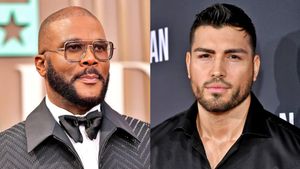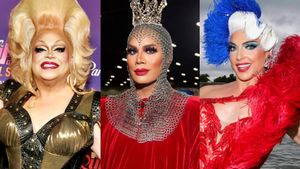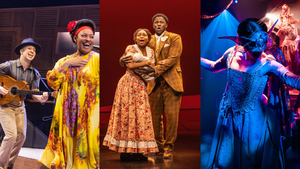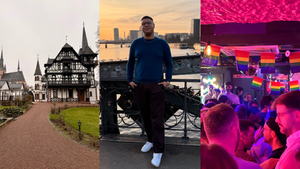This month marks the 35th year since the first cases of the human immunodeficiency virus were reported in June 1981.
The epidemic across North America, Europe, Australia, and the developing world has dramatically changed since those dark days. A "positive" diagnosis in the 1980s was often quickly followed by illness and death. The introduction of antiretroviral therapy in 1996 has saved millions of lives and revolutionized health outcomes. A "poz" diagnosis today is considered a "chronic but manageable" condition -- similar to diabetes -- when people are linked to care and antiretroviral therapy soon after diagnosis.
But not everyone has benefited from these advances.
Half of black gay and bisexual men in the United States "will be diagnosed with HIV in their lifetime" if current trends continue, according to analysis by the Centers for Disease Control and Prevention. The study was presented in late February at the Conference on Retroviruses and Opportunistic Infections in Boston, and was described as "the first-ever comprehensive national estimates of the lifetime risk of an HIV diagnosis" in every state.
To offer some perspective: The nation with the highest rate of HIV prevalence is Swaziland -- a tiny, landlocked kingdom within South Africa -- at about 27 percent prevalence. The second-highest rate is in nearby Botswana, with 25 percent. If America's black gay and bisexual men comprised a nation unto themselves, that nation would soon have the world's highest rate of infection -- twice as high as its closest rivals.
The financial burden would be staggering. The CDC estimates the average lifetime cost of treatment in this country to be about $400,000. Thousands of new cases a year means billions of dollars for HIV treatment alone. And those figures don't account for treatment for other illnesses, lost wages or productivity, or the emotional costs of depression, stigma, and anxiety.
The overall lifetime risk of an HIV infection for all Americans has dropped to 1 in 99, down from 1 in 78 a decade ago. African Americans, people who live in the South, and gay and bi men have the highest risks. The lifetime risk for "men who have sex with men," or MSM in public-health jargon, is 1 in 6. One in four Latino MSM and 1 in 11 white MSM are forecast to seroconvert -- or become HIV-positive -- in their lifetime.
The "alarming" lifetime risk estimates are "not a foregone conclusion. They are a call to action," says Jonathan Mermin, M.D., director of the CDC's National Center for HIV/AIDS, Viral Hepatitis, STD, and Tuberculosis Prevention. "Hundreds of thousands of people will be diagnosed in their lifetime if we don't scale up" prevention and care strategies.
"It's incredible that an organization which claims to be combating stigma would release this statistic that creates much more stigma," says Kenyon Farrow, the U.S. and global health policy director of the Washington-based Treatment Action Group. "But this is consistent with CDC's lack of an effective strategy toward ending the epidemic among black gay men."
"The lack of cause-and-effect information was shocking," says Preston D. Mitchum, LL.M., the policy and research analyst at the D.C.-based Center for Health and Gender Equity. "Government agencies don't really care about black men who have sex with men until they have a positive diagnosis."
African Americans and other black communities represent only 14 percent of the nation's population but account for a staggeringly disproportionate 44 percent of all new HIV infections. Black MSM -- especially teens and men in their 20s -- face the brunt of the epidemic. A growing body of research has made the case for years now.
Black MSM have been more affected by the epidemic than any other population in the world, the Black AIDS Institute reported four years ago in a study released at AIDS 2012. An estimated 1 in 2 black MSM are HIV-positive in some cities, the study adds. This was less than one year after an August 2011 CDC report noted an "alarming increase of new infections" among black MSM ages 13 to 29.
"Why isn't this a public health emergency? This probably has much to do with race and class," says Ramon Gardenhire, the AIDS Foundation of Chicago's vice president of policy and advocacy. "We see the same thing happening around the heroin epidemic in largely white suburbs. But we saw an overwhelming public-health response."
The number of fatal overdoses related to heroin and opioid use more than quadrupled between 2002 and 2013. As a result, cities, counties, states, and the federal government directed more resources into treatment, rehabilitation, and drug courts. Conversely, the response to the crack cocaine epidemic of the 1980s and 1990s, which occurred largely in heavily black metropolitan areas, was mass incarceration and harsh prosecutions.
FUELING THE EPIDEMIC
There is not one specific reason new infections are increasing among black MSM. The data show that black MSM do not practice more of what has been described as "risky behavior" -- multiple partners and intercourse without protection -- than their white counterparts. Black couples were actually "more likely to use condoms," according to a study by San Francisco State University researchers.
The release of the CDC's lifetime risk estimates -- without explanation or context -- isn't just peculiar. It feeds "into the narrative across popular culture and the media that black men and women are hypersexualized, criminals, and sexual predators," says Ravi K. Perry, Ph.D., an associate professor of political science at Virginia Commonwealth University. "We tend to hear about the black queer experience only when it is [related] to HIV or [what] is often perceived as 'irresponsible sexual behavior.' "
Lurid media coverage of black men as HIV-positive sexual predators has become sadly familiar. The case of 24-year-old Michael L. Johnson is one recent example. Johnson, a former Missouri college wrestler, was sentenced to 30 years in prison for "recklessly infecting" one male sexual partner with HIV and exposing four others to the virus in a prosecution that featured many racialized tropes. Missouri is one of at least 32 states and two territories that criminalize exposure or transmission of HIV, according to the Center for HIV Law and Policy.
These prosecutions increase stigma and make it more likely that people will not disclose their status. "Black gay men, black transgender women, and black straight men [are] more likely to be prosecuted," adds Mitchum.
Many researchers believe a "perfect storm" of health, racial, and socioeconomic barriers -- including limited access to health care and insurance, unemployment, poverty, housing insecurity, incarceration rates, homophobia, stigma, and racism -- has fueled the epidemic across black communities. These factors have been exacerbated by inadequate federal, state, and local funding, as well as generations of government neglect.
Unemployment rates are usually higher among black MSM youth. "Because they are less likely to be employed, they are less likely to have health insurance, and to be diagnosed in a timely manner. So there are very high rates of unrecognized infections among young black gay men," says Gregorio Millett, M.P.H., the American Foundation for AIDS Research's vice president and director of public policy. "Then they are less likely to be in care, which means they are less likely to be able to be taking medications so they will not transmit HIV to their partners."
The high rates of new infections have not translated into more funding for prevention, adds Millett, who previously worked at the White House and was the co-author of the Obama Administration's National HIV/AIDS Strategy.
"The Department of Health and Human Services found that although black MSM comprised half of the new infections in the African-American community, most of the prevention programming was going toward heterosexuals," he says. "That is a historic imbalance that is born of homophobia."
Southern Inhospitality
The states with the highest lifetime risk of seroconversion -- with only some exceptions -- are all Southern.
"About half of the people living with HIV are in the South. Most of them are black," says Treatment Action Group's Farrow. "We see very high numbers in places like Atlanta, Miami, Baton Rouge, New Orleans, and Jackson. Those cities have become the epicenter of the epidemic. It's no longer New York or San Francisco."
The South is also the stronghold of the Republican Party. The Southern states' rejection of expanding Medicaid eligibility under the Affordable Care Act -- despite residents in those states being overwhelmingly poor and underinsured -- is another critical factor behind the increase in black MSM infections.
"The lack of health care infrastructure in the South has particularly impacted black gay men," says Farrow. "Under the Affordable Care Act, anyone who is HIV-positive can get insurance. But in [almost] all of these states the Republican governors and legislatures have refused to expand Medicaid." Arkansas and Kentucky are the only Southern states to have expanded Medicaid.
Louisiana's new Democratic governor signed an executive order in January 2016 to expand Medicaid. But funding, hiring, and red tape have delayed its rollout. Meanwhile, New Orleans and Baton Rouge experience the second- and third-highest HIV rates in the country.
Conservative politics, religion, stigma, and racism have created a challenging climate for southern black LGBT residents -- especially those who are positive.
Marvell L. Terry II is the Human Rights Campaign's HIV/AIDS project manager. Terry grew up in Memphis. He learned his positive diagnosis about eight years ago.
"There is very little culturally competent health care for us and very poor access to health care in Memphis," he says. "There is still much racism. Add to that the layer of being a black gay man in a Southern city where you have the headquarters of the Church of God in Christ, which is the largest Pentecostal denomination." There are no local organizations in Memphis that focus on black MSM health concerns, according to Terry.
It's just the opposite case in the Deep South's largest city. Atlanta is an oasis of progressive politics in a conservative state. It's also largely black and has been described as the "black San Francisco" because of its high concentration of black gay and bi men. Atlanta has the nation's fifth-highest HIV rate and is also home to the CDC. New infections are increasing at about 12 percent a year among young black gay men in Atlanta. That's been described as "one of the highest figures for HIV incidence ever recorded [in] the resource-rich world."
"Atlanta is resource-rich -- at least on paper -- when it comes to HIV services. But many of those resources do not [reach] black gay men on the street," says Atlanta resident Daniel D. Driffin, who has worked in prevention and advocacy. "There was a fiasco with Fulton County's previous health director turning away millions of dollars in funding from CDC. Fulton County now has an HIV task force. But this should have happened about eight years ago when the [federal government] began listening sessions to craft the National HIV/AIDS Strategy."
EngagED Youth
It's going to take "a multi-pronged approach to improve health outcomes, health access, health literacy, and [reduce] stigma" among black MSM, says Orlando O. Harris, Ph.D., a TAPS Fellow at the University of California-San Francisco's Center for AIDS Prevention Studies, who has researched African-American and Caribbean MSM communities. "We cannot have a one-size-fits-all intervention strategy [and we] must recognize there are many separate communities. Caribbean Americans often feel left out of prevention. The conversations have to be across generations," he adds. "We also need to have sex-positive conversations with young people."
Many of these conversations have already begun, and in many cases the youth are leading them. Driffin was one of five young black gay men -- along with Jamaal Clue, Venton Jones, Matthew Rose, and Christopher Chauncey Watson -- who founded the Young Black Gay Leadership Initiative in 2011. It's an annual conference to build capacity, training, and leadership skill sets. So far, more than 300 people have attended, including Marvell Terry.
Terry attended YBGLI's 2012 conference and was inspired to create his own foundation and annual conference in Memphis, the Red Door Foundation. Conversations with black gay and bisexual men must go beyond HIV prevention, says Terry and many others. "Can we talk about mental health, education, housing, and police brutality? Some have [told me] they can handle HIV but they can't handle another police officer beating them up."
Youth are also harnessing the power of social media to build greater health outcomes among black gay men. Driffin learned his positive diagnosis in 2008. He created a Facebook group for other "poz" black MSM around Atlanta. "It's been amazing doing day-to-day interventions and helping people discuss medications and adherence," he says. "Some have been living with HIV for 30 years, and this is the first time that they have been able to talk about their status."
PrEP
The introduction of the antiretroviral Truvada for prevention -- known as pre-exposure prophylaxis, or PrEP -- has marked a historic shift toward a biomedical HIV-prevention model. Truvada is more than 90 percent effective in preventing HIV infection if taken at least four times per week. Several states and municipalities -- including Washington State, San Francisco, and West Hollywood -- have created PrEP access programs. But many of these regions are largely white. White gay men also enjoy better access to health care and insurance.
"This is extremely problematic," says UCSF's Harris. "We have created a new disparity for black MSM. They are facing the brunt of the epidemic but cannot access [PrEP] as readily as white MSM." There is some good news: Georgia's Fulton County -- which includes much of Atlanta -- recently opened a free PrEP clinic.
PrEP has become a buzzword across LGBT media and social media. But once again there is a racial divide. Black and white people often access the Internet and news through different platforms and media. That translates into lower awareness of PrEP among blacks. A number of community-based organizations have launched PrEP awareness and access campaigns to target black audiences.
The AIDS Foundation of Chicago recently launched a PrEP awareness campaign across Chicago's South Side. PrEP4Love uses "affirming and sex-positive images of black gay men to remove some of the stigma around PrEP," says AFC's Gardenhire.
"We need to begin a national conversation around PrEP just like we had a national conversation around safe sex," says Farrow. "Everyone needs to know what it is. We need someone from CDC to go on all the black talk-radio shows -- like Tom Joyner or Rickey Smiley -- where millions are listening. The fact that they haven't done this is a failure of vision and leadership at the CDC."




































































Charlie Kirk DID say stoning gay people was the 'perfect law' — and these other heinous quotes